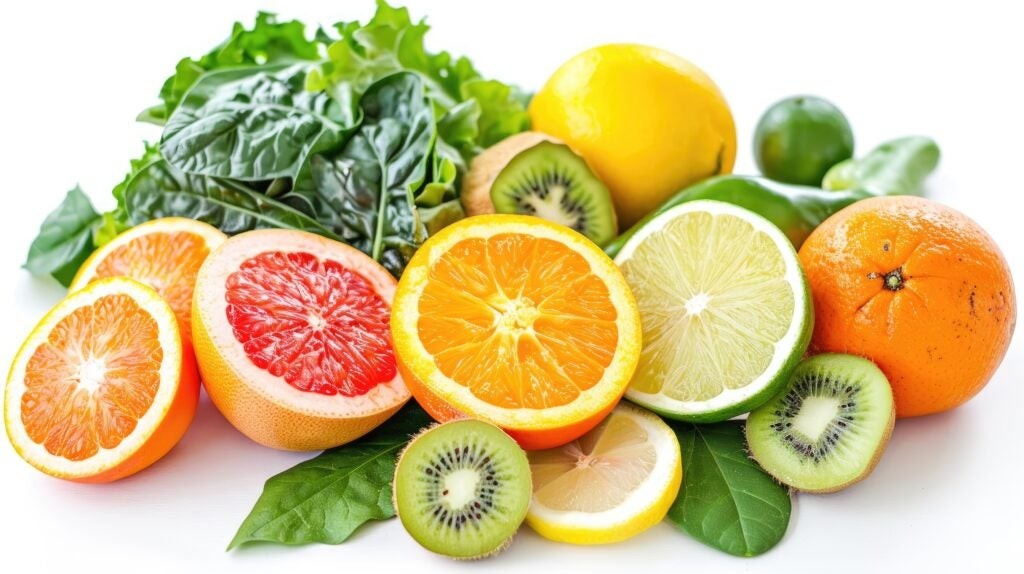Is reaching for a glass of orange juice or vitamin C supplements your first reaction when you feel a cold coming on? This instinct to load up on vitamin C became popular thanks to Linus Pauling, a Nobel laureate who advocated for high daily doses of vitamin C, suggesting it could prevent colds and chronic diseases. But What Food Has Vitamin C, and how much do you really need?
Vitamin C, also known as ascorbic acid, is a water-soluble vitamin that plays a crucial role in numerous bodily functions. Because it’s not stored well in the body, daily intake through diet or supplements is essential. Historically, the importance of vitamin C was recognized long before its scientific discovery in 1932. The ability of citrus fruits to prevent scurvy, a deadly disease for sailors in past centuries, highlighted the vital role of this nutrient.
Vitamin C is integral to immune function, wound healing, and acts as a potent antioxidant, combating harmful free radicals in the body. It’s also necessary for the production of collagen, a key protein that supports various systems throughout the body, including the nervous, immune, skeletal, and cardiovascular systems. Furthermore, vitamin C aids in the synthesis of certain hormones and neurotransmitters vital for brain and nerve function.
While high doses of vitamin C are sometimes consumed, it’s important to understand the optimal amount needed for health and whether excessive intake could be detrimental. Let’s explore the recommended amounts, the best food sources, and the health benefits of vitamin C.
Recommended Daily Intake of Vitamin C
Understanding the recommended daily allowance and upper limits for vitamin C is key to optimizing your health without overdoing it.
- Recommended Dietary Allowance (RDA): For adults aged 19 and older, the RDA for vitamin C is 90 mg daily for men and 75 mg for women. During pregnancy, this increases to 85 mg daily, and for breastfeeding women, it’s 120 mg daily. Smokers require an additional 35 mg daily due to the vitamin C-depleting effects of smoking.
- Tolerable Upper Intake Level (UL): The UL for vitamin C is 2000 mg per day. Consuming amounts exceeding this limit may lead to gastrointestinal issues like diarrhea. Higher doses are sometimes used in specific medical situations under strict supervision, such as in clinical trials.
Vitamin C Absorption and High Doses
The body’s ability to absorb vitamin C is not limitless. Studies indicate that vitamin C absorption rates decrease significantly, dropping below 50%, when intake exceeds 1000 mg. For healthy adults, megadoses are generally not toxic because the body reduces absorption and excretes excess vitamin C through urine once tissue saturation is reached.
However, negative effects can occur with daily intakes above 3000 mg, including diarrhea, increased risk of kidney stones (especially in those with pre-existing kidney issues), elevated uric acid levels (a gout risk factor), and increased iron absorption, which can be problematic for individuals with hemochromatosis, a condition causing iron overload.
Whether vitamin C comes from food or supplements, absorption rates are similar. In medical settings, vitamin C is sometimes administered intravenously to achieve higher blood concentrations, particularly in cancer care or research. While intravenous vitamin C at high doses hasn’t shown significant adverse effects in trials, it should be carefully monitored and avoided in patients with kidney disease or conditions like hemochromatosis and glucose 6-phosphate dehydrogenase deficiency.
While meeting the RDA for vitamin C, or slightly exceeding it, may offer protection against certain diseases, there’s no proven health advantage for healthy, well-nourished individuals to take very large doses. Some cell studies even suggest that extremely high concentrations of vitamin C can act as pro-oxidants, potentially causing tissue damage instead of providing antioxidant benefits. The effects of very high doses in humans are still not fully understood and could increase risks like kidney stones and digestive problems.
Health Benefits of Vitamin C
Vitamin C’s role as an antioxidant and its involvement in immune system function have spurred interest in its potential to protect against various diseases.
Vitamin C and Chronic Diseases
While some observational studies have suggested a link between higher vitamin C intake and reduced risk of cardiovascular disease and certain cancers, these findings are not consistently supported by controlled clinical trials. Randomized controlled trials have not demonstrated that vitamin C supplements prevent cardiovascular disease or cancer. The inconsistent data means there’s no specific vitamin C recommendation above the RDA for preventing these conditions.
Vitamin C and Age-Related Vision Diseases
Vitamin C has been proposed as a protective factor against eye conditions like cataracts and macular degeneration. However, studies using vitamin C supplements haven’t shown consistent benefits. Interestingly, a strong correlation exists between high daily consumption of fruits and vegetables and a decreased risk of cataracts, suggesting that vitamin C from food sources might be more beneficial.
Vitamin C and the Common Cold
Despite its popular image as a cold remedy, vitamin C’s effectiveness in combating colds is limited. Reviews of multiple studies indicate that high doses of supplemental vitamin C (above 500 mg daily) do not significantly prevent the common cold. However, they may slightly reduce the duration and severity of colds in some people. Some small studies suggest that vitamin C in a typical multivitamin at the onset of a cold might alleviate symptoms. But for most people, megadoses of vitamin C are not proven to prevent or significantly treat colds.
Vitamin C and Gout
The Physicians’ Health Study II, involving over 14,000 male physicians, found a modest decrease in the risk of new gout cases among men taking 500 mg of vitamin C supplements daily for up to 10 years. Other short-term studies have also indicated that vitamin C might lower blood uric acid levels, which can contribute to gout if excessively high.
Top Food Sources of Vitamin C
Fruits and vegetables are the most abundant and best sources of vitamin C. Incorporating a variety of these into your diet will help you meet your daily requirements.
- Citrus Fruits: Oranges, lemons, and grapefruit are well-known for their vitamin C content.
- Bell Peppers: Especially red and yellow bell peppers, are exceptionally high in vitamin C.
- Berries: Strawberries and kiwi are also excellent sources.
- Tomatoes: Provide a good amount of vitamin C and are versatile in cooking.
- Cruciferous Vegetables: Broccoli, Brussels sprouts, cabbage, and cauliflower are all good sources of vitamin C.
- White Potatoes: Often overlooked, white potatoes also contribute to vitamin C intake, especially when the skin is consumed.
Signs of Vitamin C Deficiency
Vitamin C deficiency is uncommon in developed countries but can occur with severely restricted diets lacking in fruits and vegetables for extended periods (a month or more with less than 10 mg daily intake). Risk factors in developed nations include diets low in fruits and vegetables, smoking, and alcohol or drug abuse.
The most prominent sign of severe vitamin C deficiency is scurvy, characterized by symptoms related to collagen loss and weakened connective tissues:
- Skin Issues: Spots caused by bleeding and bruising due to fragile blood vessels.
- Gum and Dental Problems: Swollen or bleeding gums, potentially leading to tooth loss.
- Hair Loss
- Impaired Wound Healing: Delayed healing of skin injuries.
- Fatigue and Malaise: General feelings of tiredness and discomfort.
- Iron Deficiency Anemia: Due to reduced absorption of non-heme iron.
Interesting Facts About Vitamin C
- Enhances Iron Absorption: Vitamin C significantly improves the absorption of non-heme iron, the type found in plant-based foods like leafy greens. Consuming vitamin C-rich foods or a small glass of 100% fruit juice with meals can boost iron absorption.
- Sensitive to Heat and Light: Vitamin C can be degraded by heat and light. High-temperature cooking or prolonged cooking times can reduce vitamin C content. Being water-soluble, it can also leach into cooking water. Quick cooking methods like stir-frying or blanching, and using minimal water, help preserve vitamin C. Eating fruits and vegetables raw at peak ripeness maximizes vitamin C intake.
- Topical Application in Skincare: Vitamin C serums and creams are popular in skincare because normal skin has high vitamin C concentrations, which stimulate collagen production and protect against UV damage. However, research suggests that topical vitamin C has limited skin penetration and may not provide additional benefits if dietary intake is adequate.
Related Resources
Vitamins and Minerals
References
Last reviewed March 2023
Terms of Use
The contents of this website are for educational purposes and are not intended to offer personal medical advice. You should seek the advice of your physician or other qualified health provider with any questions you may have regarding a medical condition. Never disregard professional medical advice or delay in seeking it because of something you have read on this website. The Nutrition Source does not recommend or endorse any products.

